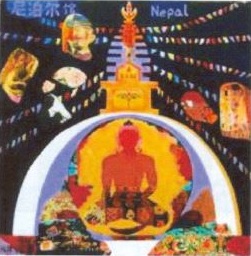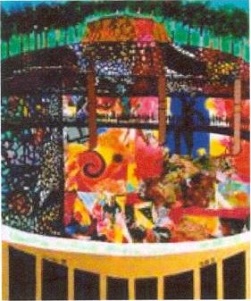
| Print | Back |  |
April 1, 2013 |
 |
Moments in Art Chen: The Soul of the Shanghai World's Fairby Lawrence Jeppson |
In a lifetime of more than eight decades I have been privileged to view art at International Expositions (World’s Fairs) in San Francisco, Bruxelles, Seattle, Montreal, and New York; at big-time international art fairs in New York, Washington, Paris, Basle, Venice, and Madrid; at hundreds of museums and galleries in the United States and Canada, Europe, and Asia. These have given me a wide, profound, and varied experience, visiting and thinking about man’s artistic means and manipulations over several millennia.
As I think back over these many manifestations, I see that most of them were narrow in scope. ARCO in Madrid, the Basle Art Fair, the Biennale in Venice are all composed of individual pavilions or booths which, usually, fixate on a single painter or a small national group.
Many of the most impressive museum shows to penetrate my lasting consciousness have been one-man retrospectives: Jan Vermeer at the National Gallery inWashington, Emile Nolde in a museum in Tokyo, James Rosenquist at the Houston Museum, and Jasper Johns graphics at the Reina Sophia in Madrid.
Later this year, my good friend Dr. Tsing-fang Chen and his wife Lucia plan to have his own pavilion in Italy at the prestigious but expensive Venice Triennial. They have asked that I be listed as the curator.
Naturally, most of the art pavilions at the world’s fairs tend to be nationalistic, and the most prominent artistic manifestations tend to be architectural: the Atomium in Bruxelles, the Space Needle in Seattle, the Buckminister Fuller Geodesic Dome in New York.
Then came the World’s Fair to trump all World’s Fairs: the massive, encompassing, and pulsating Shanghai World’s Fair of 2010. And unlike all these other manifestations I have alluded to, there was a single artist with the skill, intelligence, and stamina to make a binding interpretation of the entire fair. No souvenir book of photographs (or scholarly examination for that matter) will ever approach the vivacity, beauty, understanding, drama, and intellectual and emotional penetration as the 100 paintings of the Fair done by Dr. Chen, a Taiwanese American. (That Ph.D. is from the Sorbonne in Paris, for which he wrote a huge, two volume treatise on Chinese calligraphy and modern art.)
Chen is without peer. He is the most intellectually and internationally challenging artist at work anywhere in the world today. I would like to document this assertion, but there isn’t space here.
Although organized to show the world, including itself, China’s place in the world, the six-month Fair, more than any other ever organized, showed off the global world and its myriad cultures, that whole world of which China is a part. Chen set about to capture the entire spirit of the Fair and its many breath-taking components. So far as I am aware, no one has ever done this for any previous World’s Fair, Art Fair, or museum/gallery manifestation.
Chen set up his headquarters studio just outside the Fair’s perimeter, from which he went into the fair every day to absorb and to paint. He also had art on exhibit within the fair itself, and on the night the fair closed his friends hastily spirited away the paintings from the fairgrounds – just before the Chinese government imposed a freeze blocking art from being removed.
Chen studied each pavilion, its outward symbols, its inner meaning, its people, its places, its reality, and its aspirations. Then, using his brilliant mind and his highly developed genius for finding and combining a plethora of icons, he painted a philosophical and esthetic portrait of each of the pavilions, one by one.
When taken as a body, this collection of at least 100 large paintings captures, more than any photographic reportage can ever do, the soul of the Fair.
An icon can be any visual entity. Chen’s genius does not rest just on his ability to choose icons. The genius also demands visual success in depicting and arranging these icons and in the artist’s extraordinary command of compositional color. Chen’s bright and juxtaposed colors jab right into the heart of emotional responses. Few painters have that gift.
Because of the paintings’ complexities, viewers many not immediately recognize everything they are seeing. That is one of the marvels of great paintings: a viewer can always find something not seen before.
Beginning a tradition I started in 1978, when I wrote my first book about Chen, I have written individual critiques about several hundred Chen paintings. I identify and explain the icons Chen has used in each painting. In recent years, this torch has been picked up by Julie Chen, who has developed an acute and concise way of unlocking keys to her father’s paintings. But Chen’s output is prodigious, and for the most part viewers are left to make their own unguided discoveries.
A viewer is not obliged to identify the source of the icons in a given piece in order to enjoy the art or be moved by it. In some cases critiques may be just as harmful as helpful: most often, there can be more than one explanation or interpretation. Chen is quite capable of making visual puns and playing with the viewer. And sometimes the critic – me – can play games, too.
The first painting I described in that first book was called Guess Who’s Coming to Dinner. In the background, and occupying the biggest part of the painting, is a depiction of Henri Matisse’s large nude Odalisque with Tambourine. The foreground is from a well-known photograph of Matisse and his wife at the dinner table.
I wrote, “Matisse’s abstracted expression suggests he is conjuring the painting and perhaps wishing it would take life and converse. The dour wife seems to be in a different world. . . Matisse may be surprised when Odalisque climbs off her chair to sup with them; his wife will have apoplexy.”


[For more about Chen see my column “Finding a Name”. I will write future columns about him, for there is much to tell.]
| Copyright © 2024 by Lawrence Jeppson | Printed from NauvooTimes.com |